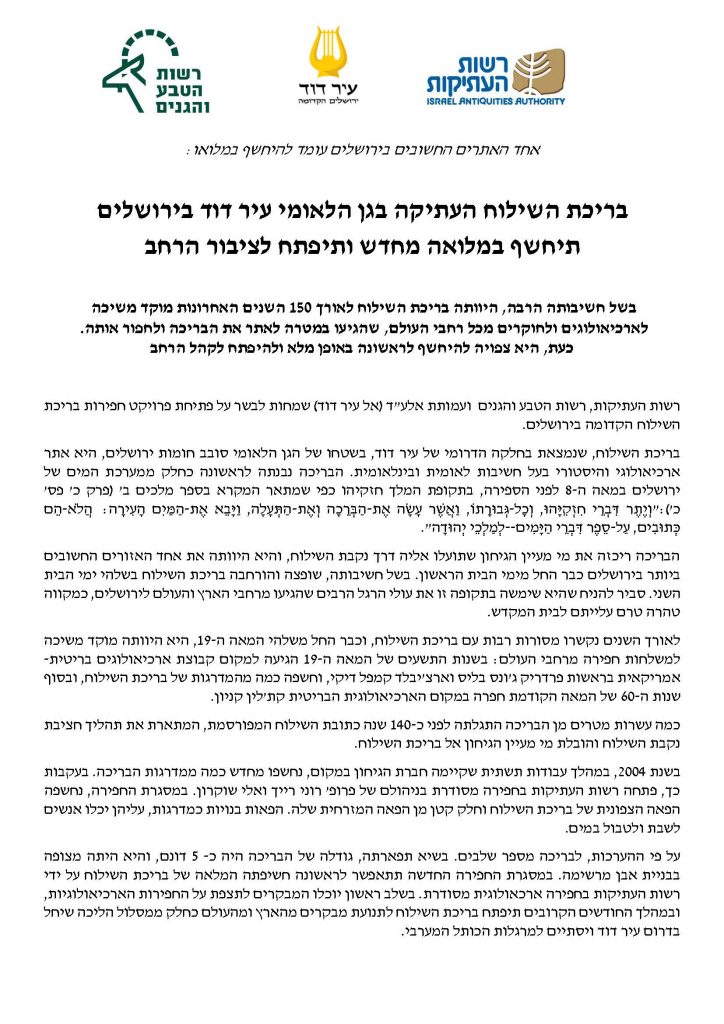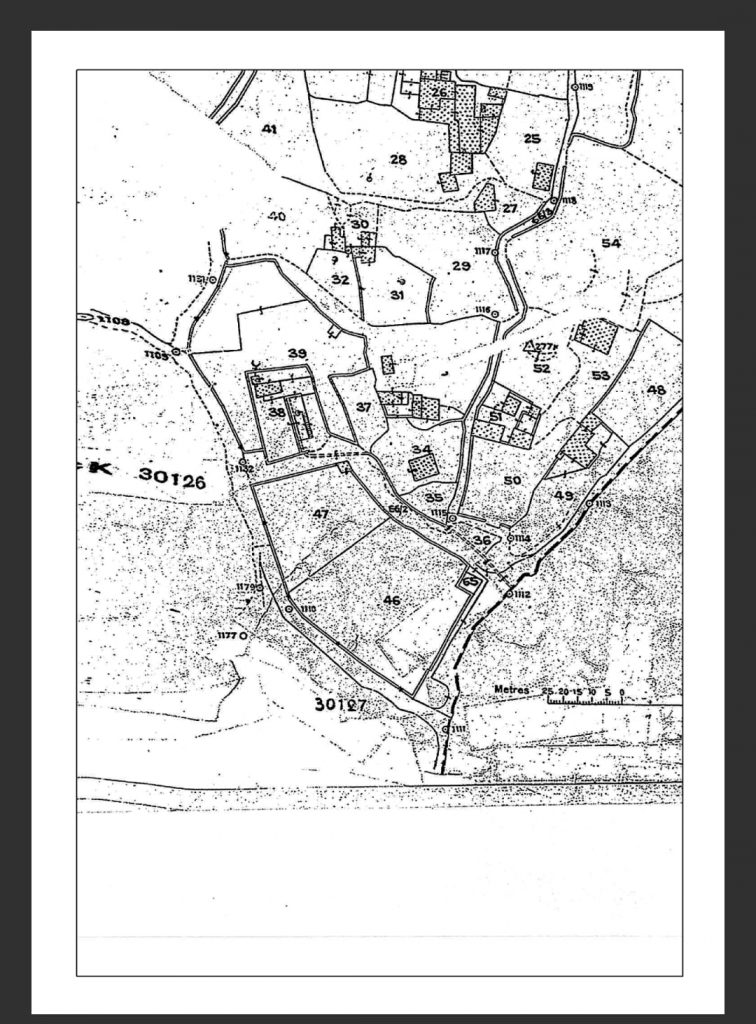This update deals with an important development in Silwan requiring close attention. It is not only highly significant in and of itself, but a likely harbinger of things to come.
What happened?
On December 27, 2022, the Elad settlers of Silwan accompanied by a heavily armed detail of Israeli police, took over a large plot of land immediately adjacent to the Pool of Siloam in Silwan (from which the name Silwan derives).
The settler takeover is not exclusively a settler initiative. In a press release touting the commencement of excavations on the site, this is being presented as a joint venture between the Elad settlers, the Israel National Parks Authority (INPA), and the Antiquities Authority (IAA). For all those needing proof, this is further evidence that in Silwan, the settlers and the Government of Israel are one of the same.
The land in question has been owned by the Greek Orthodox Church and leased to a Palestinian family since the 1930s. A family member was arrested last night (26 December) in a pre-emptive arrest, and three more were detained this morning.
The Government of Israel and the settlers have decided there is no better time to take over Church property, in a place of cardinal importance to Christianity, than the Christmas week. There is nothing new in this. The settlers and the Government customarily reserve Christmas week for their most problematic initiatives, assuming, not without reason, that the diplomats and decision-makers are all on leave and will not pay attention.

Where is the location and what is its significance?
The plot of land in question, Parcels 46 and 47 in Bloc 30125, are located at the base of Wadi Hilweh/the City of David, immediately to the west of the Pool of Siloam, beneath the southern ramparts of the Old City and in the shadow of the Al Aqsa Mosque. It is approximately 5 dunams in size (about 1.25 acres).


The Pool of Siloam is of important historical significance, particularly, but not exclusively for Jews and Christians. The Pool is associated with Hezekiah’s Tunnel (which feeds the pool) all of which were part of the ancient water system of Jerusalem in the 8th Century BC.
(See Kings 2 20:20: “As for the other events of Hezekiah’s reign, all his achievements and how he made the pool and the tunnel by which he brought water into the city, are they not written in the book of the annals of the kings of Judah?”)
For Christians, Siloam is the place where Jesus healed the blind. (See John 9:7: “And He said to him, ‘Go, wash in the pool of Siloam. So he went and washed, and came back seeing’”.)
Ownership
The reports we have heard to date, the credibility of which is unknown, indicate the following regarding the ownership of the plot in question:
The land adjacent to the Pool is/was owned by the Greek Patriarchate and was leased to the Sumarin family in 1931, who have been in possession of it ever since. In 2004, elements in the Greek Orthodox Church sold, or purported to sell, a number of Church assets to the settler of Ateret Cohanim, the most prominent of which are the two hotels at Jaffa Gate, the New Imperial Hotel and the Petra Hotel. There were indeed other transactions at that time between those Church authorities in relation to additional properties, the identities of which have not been yet revealed. The sale or purported sale of the Siloam Pool Plot is apparently the subject of one such previously undisclosed sales.
With the little we know, there are several important questions yet to be resolved:
- If the Siloam Pool was part of the 2004 transactions between Ateret Cohanim and elements in the Greek Orthodox Church, why are we discovering it only today? Are there more undisclosed transactions that have yet to be revealed?
- Why did the settlers wait 18 years before taking possession?
- The 2004 transaction was the subject of protracted legal proceedings in relation to the Imperial and Petra Hotels. Why was there no mention of the Silwan plots?
- Do the rulings in the Imperial and Petra Hotel cases, which awarded title to the settlers, serve as a precedent in for the case of the Pool of Siloam?
- To date, we have known of purported transactions between the Ateret Cohanim settlers and the Greek Orthodox Church. How did the Elad settlers of Silwan become a partly claiming ownership to the property?
- Will the Greek Orthodox Church and/or the Sumarin family institute legal proceedings against the settlers and/or the relevant government agencies?
The Context
The Narrow Context: Silwan is nestled beneath the southern ramparts of the Old City. Rich in history, Silwan is the small geographical location where the tectonic plates of Judaism Christianity, and Islam meet. Silwan is a contemporary Palestinian neighborhood in East Jerusalem. Beneath part of Silwan, Wadi Hilweh, lies the biblical City of David. Since 1991, Silwan has been the most controversial and hotly-disputed settlement in East Jerusalem. Fully backed by the Government of Israel. Extreme biblically-motivated settlers aspire to transform Silwan into a renewed manifestation of ancient Biblical Jerusalem. Evictions, displacement, archeology, national parks, demolitions, detentions, etc. have all been weapons in the arsenal of the settlers in pursuing their radical transformation of the character of Silwan. The Pool of Siloam is now the epicenter of this conflict.
For more background on Silwan, see our recent study.
The Broader Context: The takeover of the Siloam Pool is not taking place in isolation, and its significance even goes beyond its role in the settler attempt to takeover Silwan. In recent months, we have revealed the implementation of an Israeli Government Plan which entails encircling the Old City with settlements and settler-related projects (like the Pool of Siloam excavations). This plan, not only fragments Palestinian East Jerusalem, it marginalizes the Christian and Muslim presence in the Old City and its environs. We are witnessing the incorporation of the historic, religious and cultural core of Jerusalem into a biblically interpreted Israel under the de facto authority of East Jerusalem. This is not just another “bad thing” or “unhelpful unilateral step”. We are witnessing a radical transformation of the very character of Jerusalem, in ways not seen before. The evictions and demolitions in Silwan and Sheikh Jarrah, the cable car, the National Park on the Mount of Olives (see our recent report), the creation of an Israeli night spot in the Christian Quarter are intimately related: they are parts of a puzzle that disclose this unprecedented encirclement of the Old City. The takeover of the Siloam Pool is another part of that puzzle.
The German Publication, Der Spiegel, published a comprehensive and superbly-written piece of investigative journalism dealing with these dynamics and developments. The original German-language feature can be accessed online here and the print version here. For your exclusive convenience, we also attach a preliminary English translation only for internal use.
What happens next?
Insofar as this is a coordinated and coherent plan being implemented as a joint venture between the Government of Israel and the settlers, we expect to see many more developments resembling these in the near future. The new Israeli Government will likely be even more sympathetic and supportive of these endeavors than the outgoing one, and their methods even more aggressive.
The conclusion is that it is imperative to be very vigilant regarding developments that fall within the scope of the governmental plan: Sheikh Jarrah, Mount of Olives, the Christian and Armenian Quartes of the Old City, Ras Al Amud, Batan al Hawa, al Bustan and Wadi Hilweh.
